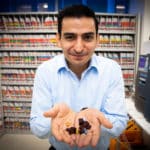Correction: an earlier version stated the tool is being formally trialed by the NSW Rural Fire Service. It is currently in use, but formal trials ended in 2016.
Firestorms are a nightmare for emergency services and anyone in their path. They occur when a bushfire meets a ‘perfect storm’ of environmental conditions and creates a thunderstorm.
Dr Rachel Badlan and Associate Professor Jason Sharples are part of a team of experts from UNSW Canberra and ACT Emergency Services that has found the shape of a fire is an important factor in whether it will turn into a firestorm.
Fires that form expansive areas of active flame, rather than spreading as a relatively thin fire-front, are more likely to produce higher smoke plumes and turn into firestorms, the researchers found.
This finding is being used to underpin further development of a predictive model for firestorms. The model was trialed in the 2015 and 2016 fire seasons by the ACT Emergency Services Agency and the NSW Rural Fire Service, and now forms part of the national dialogue around extreme bushfire development.
Continue reading The shape of a perfect storm: saving lives by predicting firestorms →












